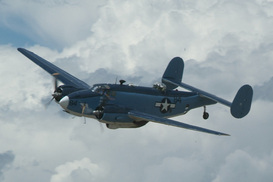ATTU WARRIOR and Dave Hansen
This US Navy PV-2 Harpoon WW II bomber was owned and maintained by Dave Hansen here at Russ McDonald Field. After a long fight with cancer, Dave Flew West on January 12th, 2018.
He will be sorely missed by the members of the CAF Wing.
This US Navy PV-2 Harpoon WW II bomber was owned and maintained by Dave Hansen here at Russ McDonald Field. After a long fight with cancer, Dave Flew West on January 12th, 2018.
He will be sorely missed by the members of the CAF Wing.
Lockheed PV-2 "Harpoon"

In 1937 Lockheed Aircraft proposed a modification of the Lockheed 18 to create a light bomber. The initial production was called the A-28 Hudson and put into service by the Royal Air Force. In 1941 the Hudson design was enlarged to create the PV-1 Ventura. The Harpoon was a major redesign of the Ventura with the wing area increased from 551 ft² to 686 ft² giving an increased load-carrying capability. The motivation for redesign was weaknesses in the PV-1, since it had shown to have poor-quality takeoffs when carrying a full load of fuel. On the PV-2, the armament became standardized at five forward-firing machine guns. Many early PV-1s had a bombardier's position, which was deleted in the PV-2. Some other significant developments included the increase of the bomb load by 30% to 4,000 lb, and the ability to carry eight 5-inch (127 mm) HVAR rockets under the wings.
While the PV-2 was expected to have increased range and better takeoff, the anticipated speed statistics were projected lower than those of the PV-1, due to the use of the same Pratt & Whitney R-2800 engines but an increase in weight. The Navy ordered 500 examples, designating them with the popular name Harpoon.
Early tests indicated a tendency for the wings to wrinkle dangerously. As this problem could not be solved by a 6 ft reduction in wingspan (making the wing uniformly flexible), a complete redesign of the wing was necessitated. This hurdle delayed entry of the PV-2 into service. The PV-2s already delivered were used for training purposes under the designation PV-2C. By the end of 1944, only 69 PV-2s had been delivered. They finally resumed when the redesign was complete. The first aircraft shipped were the PV-2D, which had eight forward-firing machine guns and was used in ground attacks. When World War II ended, all of the order was cancelled.
With the wing problems fixed, the PV-2 proved reliable, and eventually popular. It was first used in the Aleutians by VP-139, one of the squadrons that originally used the PV-1. It was used by a number of countries after the war’s end, but the United States ceased ordering new PV-2s, and they were all soon retired from service.
For a pricing and to arrange for a ride for an individual or group in this classic warbird aircraft, contact:
Dave Hansen at 435-671-3509 or see the website at Dave's Custom Sheet Metal.
Wikipedia link: HARPOON
General characteristics:
Crew: 7
Length: 51 ft 1 in
Wingspan: 75 ft
Height: 13 ft 3 in
Loaded weight: 36,000 lbs
Power Plant: Two (2) Pratt and Whitney R-2800-31s producing 2000 HP
Performance:
Maximum speed: 282 mph at 13,900 ft
Range: 1790 mi
Service ceiling: 23,900 ft
While the PV-2 was expected to have increased range and better takeoff, the anticipated speed statistics were projected lower than those of the PV-1, due to the use of the same Pratt & Whitney R-2800 engines but an increase in weight. The Navy ordered 500 examples, designating them with the popular name Harpoon.
Early tests indicated a tendency for the wings to wrinkle dangerously. As this problem could not be solved by a 6 ft reduction in wingspan (making the wing uniformly flexible), a complete redesign of the wing was necessitated. This hurdle delayed entry of the PV-2 into service. The PV-2s already delivered were used for training purposes under the designation PV-2C. By the end of 1944, only 69 PV-2s had been delivered. They finally resumed when the redesign was complete. The first aircraft shipped were the PV-2D, which had eight forward-firing machine guns and was used in ground attacks. When World War II ended, all of the order was cancelled.
With the wing problems fixed, the PV-2 proved reliable, and eventually popular. It was first used in the Aleutians by VP-139, one of the squadrons that originally used the PV-1. It was used by a number of countries after the war’s end, but the United States ceased ordering new PV-2s, and they were all soon retired from service.
For a pricing and to arrange for a ride for an individual or group in this classic warbird aircraft, contact:
Dave Hansen at 435-671-3509 or see the website at Dave's Custom Sheet Metal.
Wikipedia link: HARPOON
General characteristics:
Crew: 7
Length: 51 ft 1 in
Wingspan: 75 ft
Height: 13 ft 3 in
Loaded weight: 36,000 lbs
Power Plant: Two (2) Pratt and Whitney R-2800-31s producing 2000 HP
Performance:
Maximum speed: 282 mph at 13,900 ft
Range: 1790 mi
Service ceiling: 23,900 ft
